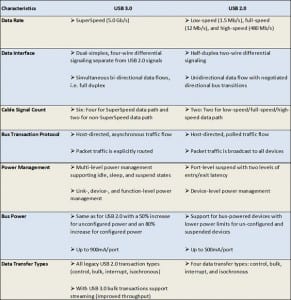USB 3.0 Performance Advantage in Workstations
This article is excerpted from a white paper from Hewlett-Packard. To read this white paper in its entirety, visit HP online.
January 2014
 USB 3.0 Performance Advantage of up to 10 times USB 2.0
USB 3.0 Performance Advantage of up to 10 times USB 2.0
This introduction to USB 3.0 technology illustrates its capability to deliver the throughput needed for high-bandwidth external I/O applications. USB 3.0 builds upon the USB ecosystem that is pervasive in the industry today; is extremely flexible; provides a robust plug-and-play experience; and can provide high data throughput to non-USB 3.0 devices, thanks to interface adapters.
As technology continues to evolve, the need for more bandwidth is becoming a requirement. High-speed external storage devices, video capture, and high definition multimedia are prevalent in today’s market. USB has become the dominant plug-and-play interconnect for PCs and it continues to grow. USB 3.0 “SuperSpeed” provides a significant performance increase over previous USB generations, making it the ideal solution for external connectivity. Unlike the single duplex USB 2.0 interface, USB 3.0 supports 5Gb/s full duplex. It also provides higher power, and is backward-compatible with USB 2.0.
USB 3.0 Benefits and Features:
- Up to 10 times greater performance over USB 2.0, with 5Gb/s full-duplex providing up to 350MB/s throughput in current implementations
- More power for devices: 900mA per port (configured)
- Significantly improved power management due to reduced active power during data transfers and improved idle power management that allows devices to drive the bus to lower power states
- Backwards compatible with USB 2.0 (USB 3.0 connectors are supersets of USB 2.0, containing both USB 3.0 and USB 2.0 signals) so it offers robust hot-swappable, plug-and-play operation, building on the existing USB 2.0 market ecosystem
- Up to 10 times faster than 1394a(400Mb/s), six times faster than 1394b (800Mb/s), and 1.5 times faster than eSATA (3Gb/s), making it the fastest industry standard external plug-and-play I/O available for personal computers
Performance
First-generation USB 3.0-capable systems did not perform to USB 3.0’s potential due to non-optimal implementations that limited the maximum throughput achievable. Current HP workstations have been designed with at least a PCI-Express lane at 2.0 speed (5Gb/s) connected to the USB 3.0 controller, allowing it to perform at its maximum throughput.
Performance testing illustrates that USB 3.0 can provide equivalent bandwidth when compared to current SATA and eSATA technologies. USB 3.0 can be used as an alternate interface to eSATA devices by using a USB 2.0-to-eSATA adapter and still preserve the device’s data throughput. Actually, USB 3.0 can even provide greater bandwidth and scalability beyond eSATA’s, with up to 350 MB/s throughput on current systems. As USB 3.0 matures, further gains in overall performance and bandwidth should be expected.
USB 3.0 is a compelling external I/O interface for high-speed needs. It is up to 10 times faster than USB 2.0, provides more power, and also builds upon the already existing USB 2.0 ecosystem. Its full support on several generations of Windows and Linux operating systems and its plug-and-play compatibility make it a robust external solution across applications, markets, and usage models.
USB 3.0 is substantially faster than other industry standard plug-and-play interfaces. SATA and eSATA devices can be supported without impacting performance by utilizing external HDD enclosures and USB 3.0-to-eSATA adapters. Other adapters, to interfaces such as 1394, Ethernet, and wireless, for instance, are also available.
It is expected that USB 3.0 will become a dominant device interface as:
- It provides up to 10 times the throughput of USB 2.0.
- It provides more power for self-powered USB devices.
- It is backward-compatible with USB 2.0, thereby leveraging the large ecosystem of existing USB 2.0 devices.
- Many external hard drives now support both USB 2.0 and USB 3.0.
- It is a robust plug-and-play interface, just like USB 2.0.
- It is supported on both Windows and Linux.
- USB 3.0 devices are becoming plentiful and readily available.
- State of the Industry: 2022-2023 Connector Sales - April 16, 2024
- Amphenol is On a Roll - April 2, 2024
- Nicomatic Proves That Two Heads are Better Than One - March 26, 2024


